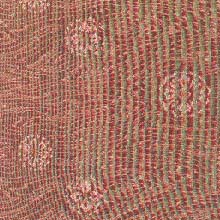Weave (p. 75 )
1. Produced in Hachioji City, Akikawa City, Tokyo.
2. Characteristics: "Mon Omeshi"(silk crepe with patterns), having high crimps
3. Uses: Clothes for female.
4. History: Hachiojiユs long history of weaving has a record showing that 350 years ago it had produced some kinds of "Tsumugi". After the Edo Period, Hachioji has been known as the most famous site for producing fabrics in the Kanto District, the area covering several prefectures around Tokyo. All the fabrics made were for the men at first, but those for the women were developed in the Taisho Period(1912-1926) when westernized clothes for the men became popular and the need for traditional clothes decreased. In 1926 silk serge was produced for the first time in Japan by the Jacquard pattern weaving machine. "Tama Yuki" was successfully developed in 1928 and since then, Hachioji has been the center of fabrics in Japan, mostly producing fabrics for use by women. In the 30ユs of Showa(1955-64), silk-wool combined weave was a boom but today, "Tama Yuki" silk crepe is very highly re-evaluated.



